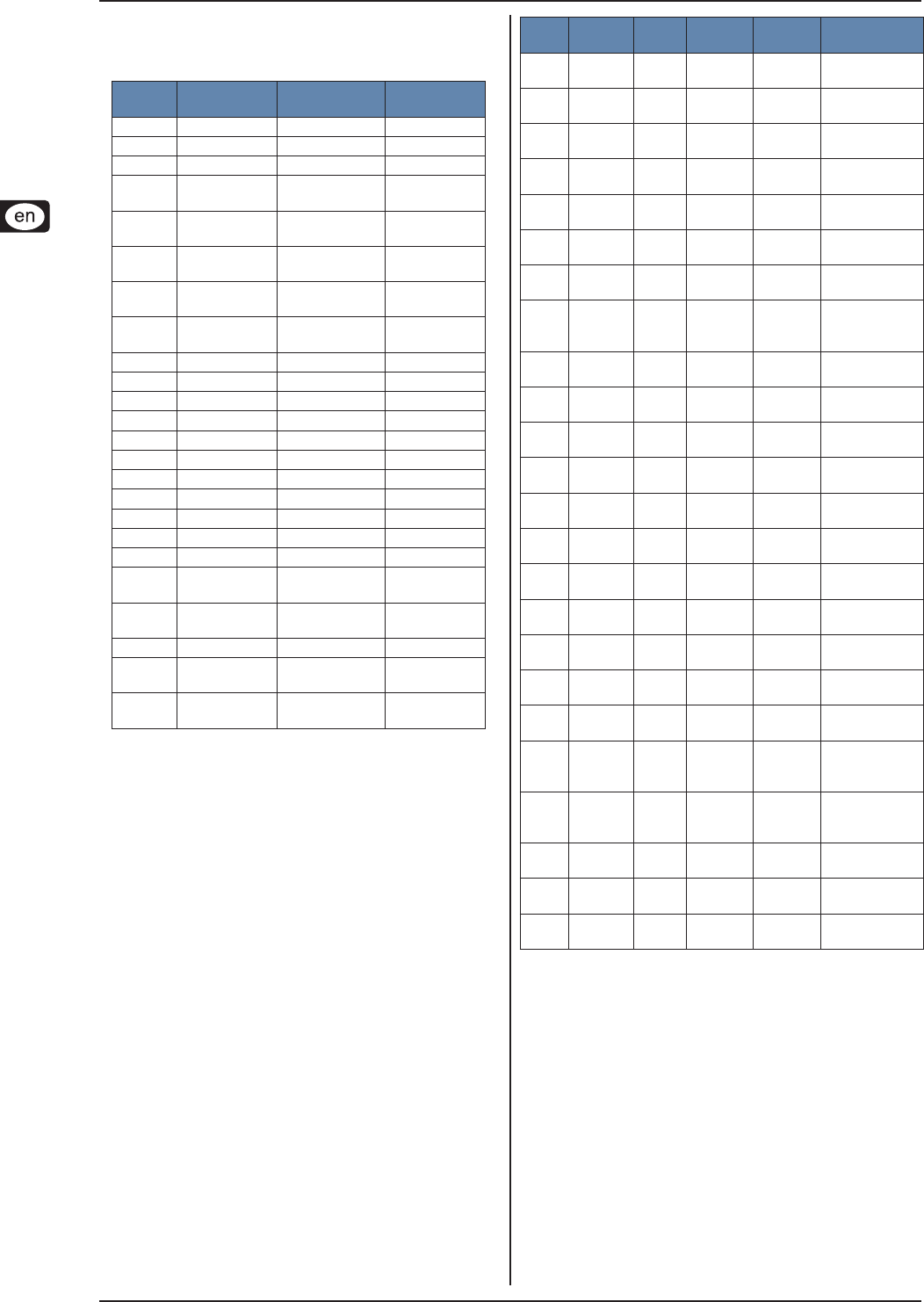
EURODESK SX4882
Live concert with 24-track recording22
Live concert with 24-track recording18.
Stereo (quadraphonic) P.A. with sidells, three inlls, two wedge
mixes, four FX and simultaneous 24-track recording.
Chan-
nels
Source Tape route Destination
1 Kick Direct out Track 1
2 Snare Direct out Track 2
3 Hi Hat Direct out Track 3
4 Tom 1
Subgroups 5
and 6
Tracks 5 and 6
5 Tom 2
Subgroups 5
and 6
Tracks 5 and 6
6 Tom 3
Subgroups 5
and 6
Tracks 5 and 6
7 Tom 4
Subgroups 5
and 6
Tracks 5 and 6
8
Cymbals
(overheads)
Direct out Track 4
9 Keyboards L Direct out Track 7
10 Keyboards R Direct out Track 8
11 Bass DI Direct out Track 9
12 Trumpet Direct out Track 10
13 Trombone Direct out Track 11
14 Sax Direct out Track 12
15 BVs 1 Direct out Track 13
16 BVs 2 Direct out Track 14
17 BVs 3 Direct out Track 15
18 Conga L Direct out Track 16
19 Conga R Direct out Track 17
20
Guitar 1
microphone
Direct out Track 18
21
Guitar 2
microphone
Direct out Track 19
22 Lead vocal Direct out Track 20
23
Main echo /
reverb return
(Send = aux 3) Track 21
24
Main echo /
reverb return
(Send = aux 3) Track 22
Channel assignments 24-track Tab. 18.1:
(track 24 pre-striped with SMPTE)
None of the tape tracks can be auditioned in this conguration.
The channel fader controls the level to tape, MIX-B adjusts the
P.A. level.
The channel inserts (which are pre fader), may be used as virtual
direct outs. Hopefully you will be able to set the input gains (P2)
to suit the multitrack on any channel that does not have a massive
EQ (i.e. energy) swing away from 0 dB. The consequent lack of
any desk EQ on your tape tracks might even be an advantage
when it comes to remixing the concert back in the studio.
Using this setup, you can even change the P.A. to a quadrophonic
system. Positioning takes place by balancing the main mix (chan-
nel fader, PANpot P24) against MIX-B (P20, P21).
Chan-
nels
Source F.O.H. FX Wedges Inlls
1 Kick MIX-B - -
Subgroups 1/2,
3/4 and 7/8
2 Snare MIX-B
Aux send
4
Aux send
1 and 2
Subgroups 1/2
and 3/4
3 Hi Hat MIX-B - -
Subgroups 1/2
and 3/4
4 Tom 1 MIX-B
Aux send
4
- -
5 Tom 2 MIX-B
Aux send
4
- -
6 Tom 3 MIX-B
Aux send
4
- -
7 Tom 4 MIX-B
Aux send
4
- -
8
Cymbals
(over-
heads)
MIX-B - - -
9
Key-
boards L
MIX-B - - Subgroup 12
10
Key-
boards R
MIX-B - - Subgroup 12
11 Bass DI MIX-B - -
Subgroups 1/2,
3/4 and 7/8
12 Trumpet MIX-B
Aux send
5
- -
13
Trom-
bone
MIX-B
Aux send
5
- -
14 Sax MIX-B
Aux send
5
- -
15 BVs 1 MIX-B
Aux send
5 and 6
Aux send
1 and 2
-
16 BVs 2 MIX-B
Aux send
5 and 6
Aux send
1 and 2
-
17 BVs 3 MIX-B
Aux send
5 and 6
Aux send
1 and 2
-
18 Conga L MIX-B - -
Subgroups 1/2,
3/4 and 7/8
19 Conga R MIX-B - -
Subgroups 1/2,
3/4 and 7/8
20
Guitar 1
micro-
phone
MIX-B - -
Subgroups 3
and 4
21
Guitar 2
micro-
phone
MIX-B - -
Subgroups 3
and 4
22
Lead
vocal
MIX-B
Aux send
5 and 6
Aux send
1
-
23 FX 1 L MIX-B -
Aux send
1
-
24 FX 1 R MIX-B -
Aux send
1
-
Front/rear/stage monitors routingTab. 18.2:
For front of house route all channels to the MIX-B bus > main
mix. For live P.A. effects use auxes 3/4/5/6. For wedge monitors
use aux 1 and 2 in pre mode > aux 1and 2 output. For sidells
use phones 1 output. For inll for guitarist, keyboard player and
drummer use subgroups 1/2, 3/4 and 7/8.
No subgrouping is used as a mixing aid to the FOH +
mix.
Inll sends use up one group pair each as a conse- +
quence of the routing matrix being dependent on the
channel PANpot (P24).
All channels should be set for: aux 1/2: PRE (S13 DOWN) +
> WEDGES; aux 3/4/5/6: POST (S16 UP) > FX; MIX-B
SOURCE = CHANNEL (S23 DOWN); FLIP = Mic/Line
SIGNAL (S3 UP)


















